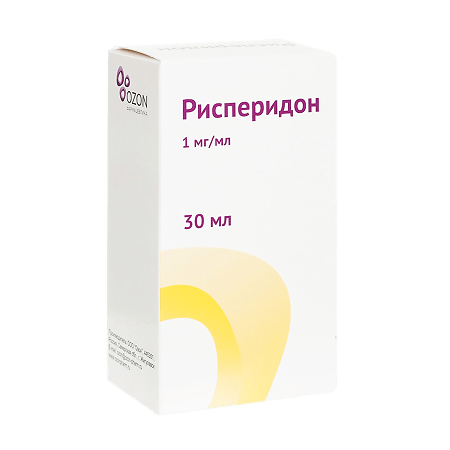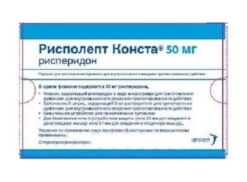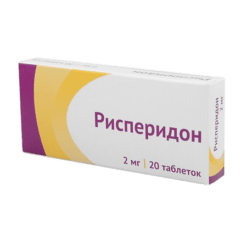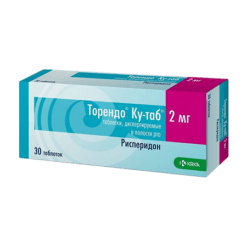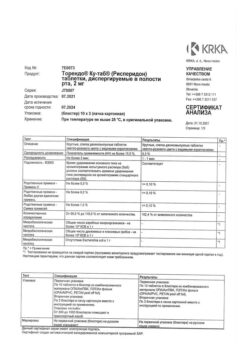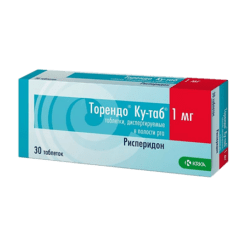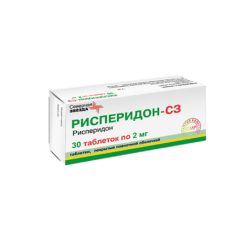No products in the cart.
Risperidone, 1 mg/ml 30 ml
€7.32 €6.10
Out of stock
(E-mail when Stock is available)
Description
Pharmacotherapeutic group:antipsychotic drug (neuroleptic).
ATX code N05AX08
Pharmacological properties
Pharmacodynamics
Risperidone is a selective monoaminergic antagonist with high affinity for serotonergic 5-NT2 and dopaminergic D2 -receptors. Risperidone also binds to α1-adrenergic receptors and, somewhat weaker, to H1 -histaminergic and α2 -adrenergic receptors. Risperidone has no tropism to cholinergic receptors. Risperidone reduces the productive symptomatology of schizophrenia, causes less suppression of motor activity and is less likely to induce catalepsy than classical neuroleptics. Balanced central antagonism to serotonin and dopamine probably reduces the propensity for extrapyramidal side effects and extends the therapeutic effects of the drug to include negative and affective symptoms of schizophrenia.
Pharmacokinetics
Intake
Risperidone is completely absorbed after oral administration, reaching maximum plasma concentrations in 1-2 hours. The absolute bioavailability of risperidone after oral administration is 70%. The relative bioavailability after oral administration of risperidone in tablet form is 94 % compared to risperidone in solution form. Food has no effect on absorption of the drug, therefore risperidone may be prescribed regardless of meals. The equilibrium concentration of risperidone in the body in most patients is reached within 1 day. The equilibrium concentration of 9-hydroxirisperidone is reached within 4-5 days.
Distribution
Risperidone is rapidly distributed in the body. The volume of distribution is 1-2 l/kg. In plasma, risperidone binds to albumin and alpha1-acid glycoprotein. Risperidone is 90% bound by plasma proteins, 9-hydroxysperidone – by 77%.
Metabolism and excretion
Risperidone is metabolized by CYP 2D6 isoenzyme to 9-hydroxyrisperidone, which has similar pharmacological effects to risperidone. Risperidone and 9-hydroxysperidone constitute the active antipsychotic fraction. The CYP 2D6 isoenzyme is subject to genetic polymorphism. In patients with intensive metabolism by CYP 2D6 isoenzyme, risperidone is rapidly converted to 9-hydroxyrisperidone, while in patients with poor metabolism, this transformation is much slower. Although patients with intensive metabolism have lower risperidone concentrations and higher 9-hydroxysperidone concentrations than patients with poor metabolism, the total pharmacokinetics of risperidone and 9-hydroxysperidone (active antipsychotic fraction) after one or more doses are similar in patients with intensive and with poor CYP 2D6 metabolism.
The other pathway of risperidone metabolism is N-dealkylation. In vitro studies on human liver microsomes have shown that risperidone in clinically significant concentrations generally does not inhibit the metabolism of drugs undergoing biotransformation by P450 system isoenzymes, including CYP 1A2, CYP 2A6, CYP 2C8/9/10, CYP 2D6, CYP 2E1, CYP 3A4 and CYP 3A5. One week after the start of the drug, 70% of the dose is excreted in the urine, 14% – in the feces. In the urine, risperidone together with 9-hydroxyrisperidone make up 35-45% of the dose. The remaining amount consists of inactive metabolites. After oral administration in patients with psychosis, risperidone is eliminated from the body with a half-life (T1/2) of about 3 hours. The T1/2 of 9-hydroxysperidone and the active antipsychotic fraction is 24 hours.
Linearity
The plasma concentration of risperidone is directly proportional to the dose taken in the therapeutic dose range.
Elderly patients and patients with hepatic and renal impairment
After a single dose of risperidone, older patients had on average 43% higher plasma concentrations of the active antipsychotic fraction, a 38% longer half-life, and a 30% decrease in clearance. In patients with renal insufficiency, increased plasma concentrations and decreased clearance of the active antipsychotic fraction by 60% on average were observed. In patients with hepatic insufficiency, plasma concentrations of risperidone did not change, but the average concentration of the free fraction of risperidone increased by 35%.
Children
The pharmacokinetics of risperidone, 9-hydroxysperidone and the active antipsychotic fraction in children are comparable to those in adult patients.
The influence of sex, race, and smoking
Population pharmacokinetic analysis showed no apparent effect of sex, race, or smoking on the pharmacokinetics of risperidone and the active pharmacokinetic fraction.
Indications
Indications
treatment of schizophrenia in adults and children over 13 years of age;
treatment of moderate to severe manic episodes associated with bipolar disorder in adults and children over 10 years of age;
short-term (up to 6 weeks) treatment of persistent aggression in patients with moderate to severe Alzheimer’s dementia that is not amenable to non-pharmacological treatment and when the patient is at risk of causing harm to himself or others;
short-term (up to 6 weeks) symptomatic treatment of persistent aggression in the structure of conduct disorder in children over 5 years of age with mental retardation diagnosed in accordance with DSM-IV, in which, due to the severity of aggression or other destructive behavior, drug treatment is required. Pharmacotherapy should be part of a broader treatment program, including psychological and educational interventions. Risperidone should be prescribed by a specialist in child neurology and child psychiatry or a physician knowledgeable in the treatment of conduct disorders in children and adolescents.
Pharmacological effect
Pharmacological effect
Pharmacotherapeutic group:
antipsychotic (neuroleptic).
ATX code N05AX08
Pharmacological properties
Pharmacodynamics
Risperidone is a selective monoaminergic antagonist with high affinity for serotonergic 5-HT2 and dopaminergic D2 receptors. Risperidone also binds to α1-adrenergic receptors and, somewhat weaker, to H1-histamine and α2-adrenergic receptors. Risperidone does not have tropism for cholinergic receptors. Risperidone reduces the productive symptoms of schizophrenia, causes less suppression of motor activity and induces catalepsy to a lesser extent than classical antipsychotics. Balanced central antagonism of serotonin and dopamine likely reduces the propensity for extrapyramidal side effects and extends the therapeutic effect of the drug to include negative and affective symptoms of schizophrenia.
Pharmacokinetics
Suction
Risperidone is completely absorbed after oral administration, reaching maximum plasma concentrations within 1-2 hours. The absolute bioavailability of risperidone after oral administration is 70%. The relative bioavailability after oral administration of risperidone in tablet form is 94% when compared with risperidone in solution form. Food does not affect the absorption of the drug, so risperidone can be prescribed regardless of food intake. The equilibrium concentration of risperidone in the body is achieved within 1 day in most patients. The equilibrium concentration of 9-hydroxyrisperidone is achieved within 4-5 days.
Distribution
Risperidone is rapidly distributed in the body. The volume of distribution is 1-2 l/kg. In plasma, risperidone binds to albumin and alpha1-acid glycoprotein. Risperidone is 90% bound to plasma proteins, 9-hydroxyrisperidone is 77% bound.
Metabolism and excretion
Risperidone is metabolized by the CYP2D6 isoenzyme to 9-hydroxyrisperidone, which has a pharmacological effect similar to risperidone. Risperidone and 9-hydroxyrisperidone constitute the active antipsychotic fraction. The CYP 2D6 isoenzyme is subject to genetic polymorphism. In patients who are extensive metabolizers of the CYP2D6 isoenzyme, risperidone is rapidly converted to 9-hydroxyrisperidone, while in patients who are poor metabolizers, this transformation occurs much more slowly. Although extensive metabolizers have lower concentrations of risperidone and higher concentrations of 9-hydroxyrisperidone than poor metabolizers, the net pharmacokinetics of risperidone and 9-hydroxyrisperidone (the active antipsychotic fraction) after single or multiple doses are similar in extensive and poor metabolizers of CYP 2D6.
Another route of metabolism for risperidone is N-dealkylation. In vitro studies on human liver microsomes have shown that risperidone, at clinically relevant concentrations, generally does not inhibit the metabolism of drugs biotransformed by P450 isoenzymes, including CYP 1A2, CYP 2A6, CYP 2C8/9/10, CYP 2D6, CYP 2E1, CYP 3A4 and CYP 3A5. A week after starting the drug, 70% of the dose is excreted in the urine, 14% in feces. In urine, risperidone together with 9-hydroxyrisperidone constitute 35-45% of the dose. The remaining amount consists of inactive metabolites. After oral administration in patients with psychosis, risperidone is eliminated from the body with a half-life (T1/2) of about 3 hours. T1/2 of 9-hydroxyrisperidone and the active antipsychotic fraction is 24 hours.
Linearity
Plasma concentrations of risperidone are directly proportional to the dose administered over the therapeutic dose range.
Elderly patients and patients with liver and kidney failure
Following a single dose of risperidone in elderly patients, plasma concentrations of the active antipsychotic fraction were on average 43% higher, the half-life was 38% longer, and clearance was reduced by 30%. In patients with renal failure, an increase in plasma concentration and a decrease in clearance of the active antipsychotic fraction by an average of 60% was observed. In patients with hepatic impairment, plasma risperidone concentrations did not change, but the mean free risperidone concentration increased by 35%.
Children
The pharmacokinetics of risperidone, 9-hydroxyrisperidone and the active antipsychotic fraction in children is comparable to that in adult patients.
Effects of Gender, Race, and Smoking
Population pharmacokinetic analysis revealed no apparent influence of gender, race, or smoking on the pharmacokinetics of risperidone and the active pharmacokinetic fraction.
Special instructions
Special instructions
Use in elderly patients with dementia.
Increased mortality in older patients with dementia
Elderly patients with dementia treated with atypical antipsychotics experienced increased mortality compared with placebo in studies of atypical antipsychotics, including risperidone. When using risperidone in this population, the incidence of death was 4.0% for patients taking risperidone compared with 3.1% for placebo. The mean age of patients who died was 86 years (range, 67–100 years). Data collected from two large observational studies show that older patients with dementia treated with typical antipsychotic medications also have a slightly increased risk of death compared with patients not treated. At present, insufficient data have been collected to accurately assess this risk. The reason for the increase in this risk is also unknown. Also, the extent to which the increased mortality may be attributable to antipsychotic drugs rather than to the characteristics of this patient population has not been determined.
Combined use with furosemide
In elderly patients with dementia, there was an increased mortality rate when taking furosemide and oral risperidone concomitantly (7.3%, mean age 89 years, range 75-97 years) compared with the risperidone-only group (3.1%, mean age 84 years, range 70-96 years) and the furosemide-alone group (4.1%, mean age 80 years, range 67-90 years old). An increase in mortality in patients taking risperidone with furosemide was observed in 2 of 4 clinical studies. Concomitant use of risperidone with other diuretics (mainly low-dose thiazide diuretics) was not associated with an increase in mortality.
No pathophysiological mechanisms have been established to explain this observation. However, special care should be taken when prescribing the drug in such cases. Before prescribing, the risk/benefit ratio must be carefully assessed. There was no increase in mortality in patients taking other diuretics concomitantly with risperidone. Regardless of treatment, dehydration is a common risk factor for mortality and should be carefully monitored in older patients with dementia.
In elderly patients with dementia, an increase in cerebrovascular adverse events (acute and transient cerebrovascular accidents), including patient deaths (mean age 85 years, range 73-97 years) was observed with risperidone compared with placebo.
Cardiovascular effects.
In placebo-controlled clinical trials, an approximately 3-fold increased risk of cerebrovascular side effects was observed in patients with dementia taking certain atypical antipsychotic drugs. Pooled data from 6 placebo-controlled studies involving primarily elderly patients with dementia (age >65 years) demonstrate that cerebrovascular adverse events (serious and non-serious) occurred in 3.3% (33/1009) of patients treated with risperidone and in 1.2% (8/712) of patients treated with placebo. The risk ratio was 2.96 (1.34, 7.50) with a 95% confidence interval. The mechanism by which this risk increases is unknown. An increased risk cannot be excluded for other antipsychotic drugs, as well as for other patient populations. Rispolept® should be used with caution in patients with risk factors for stroke.
The risk of cerebrovascular side effects is much higher in patients with mixed or vascular dementia compared to patients with Alzheimer’s dementia. Therefore, patients with any type of dementia other than Alzheimer’s should not take risperidone.
Physicians should assess the risk/benefit ratio of using Rispolept® in elderly patients with dementia, taking into account the precursors of stroke risk individually for each patient. Patients and caregivers should be cautioned to immediately report signs and symptoms of cardiovascular events, such as sudden weakness or stiffness/numbness in the face, legs, arms, as well as difficulty speaking and vision problems. All possible treatment options should be considered, including discontinuation of risperidone.
Rispolept® should only be used for the short-term treatment of persistent aggression in patients with moderate to severe Alzheimer’s dementia, as an adjunct to non-pharmacological treatments when they are ineffective or of limited effectiveness, and when there is a risk of harm to the patient to himself or others.
Patients’ condition and the need for continued risperidone therapy should be continually assessed.
Orthostatic hypotension.
Risperidone has alpha-blocking activity and may therefore cause orthostatic hypotension in some patients, especially during initial dose titration. Clinically significant hypotension has been observed in the post-marketing period when used concomitantly with antihypertensive drugs. Rispolept® should be used with caution in patients with known cardiovascular disease (eg, heart failure, myocardial infarction, cardiac conduction disorders, dehydration, hypovolemia or cerebrovascular disease). Appropriate dose adjustment is also necessary. It is recommended to evaluate the possibility of dose reduction if hypotension occurs.
Tardive dyskinesia and extrapyramidal disorders.
Drugs with dopamine receptor antagonist properties can cause tardive dyskinesia, which is characterized by rhythmic involuntary movements, mainly of the tongue and/or facial muscles. The occurrence of extrapyramidal symptoms is a risk factor for the development of tardive dyskinesia. If a patient experiences objective or subjective symptoms indicating tardive dyskinesia, the advisability of discontinuing all antipsychotic drugs, including Rispolept®, oral solution, should be considered.
Neuroleptic malignant syndrome (NMS).
Antipsychotics, including risperidone, may cause neuroleptic malignant syndrome (NMS), which is characterized by hyperthermia, muscle rigidity, instability of autonomic nervous system function, depression of consciousness, and increased serum concentrations of creatine phosphokinase. Myoglobinuria (rhabdomyolysis) and acute renal failure may also occur in patients with NMS. If a patient experiences objective or subjective symptoms of NMS, all antipsychotic drugs, including Rispolept®, must be immediately discontinued.
Parkinson’s disease and dementia with Lewy bodies.
Antipsychotic medications, including Rispolept®, should be prescribed with caution to patients with Parkinson’s disease or dementia with Lewy bodies. Both groups of patients have an increased risk of developing neuroleptic malignant syndrome and increased sensitivity to antipsychotic drugs (including dullness of pain sensitivity, confusion, postural instability with frequent falls and extrapyramidal symptoms). Parkinson’s disease may worsen when taking risperidone.
Hyperglycemia and diabetes mellitus.
Hyperglycemia, diabetes mellitus, and exacerbation of existing diabetes mellitus were observed during treatment with Rispolept®. It is likely that weight gain prior to treatment is also a predisposing factor. Very rarely, ketoacidosis and rarely, diabetic coma can occur. All patients should be clinically monitored for symptoms of hyperglycemia (such as polydipsia, polyuria, polyphagia and weakness).
Patients with diabetes mellitus should be regularly monitored for worsening glucose control.
Increase in body weight.
During treatment with Rispolept®, a significant increase in body weight was observed. It is necessary to monitor patients’ body weight.
Hyperprolactinemia.
Based on the results of tissue culture studies, it has been suggested that the growth of breast tumor cells may be stimulated by prolactin. Although clinical and epidemiological studies have not shown a clear association between hyperprolactinemia and antipsychotic drug use, caution should be exercised when prescribing risperidone to patients with a history of this. Rispolept® should be used with caution in patients with existing hyperprolactinemia and in patients with possible prolactin-dependent tumors.
Prolongation of the QT interval.
QT prolongation has been observed very rarely during post-marketing surveillance. As with other antipsychotics, caution should be exercised when prescribing Rispolept® to patients with known cardiovascular diseases, family history of QT interval prolongation, bradycardia, electrolyte imbalance (hypokalemia, hypomagnesemia), as this may increase the risk of an arrhythmogenic effect; and when used together with drugs that prolong the QT interval.
Cramps.
Rispolept® should be used with caution in patients with a history of seizures or other medical conditions that may lower the seizure threshold.
Priapism.
Priapism may occur with risperidone due to alpha-blocking effects.
Regulation of body temperature.
Antipsychotic drugs are associated with such undesirable effects as disruption of the body’s ability to regulate temperature. Caution should be exercised when prescribing Rispolept® to patients with conditions that may contribute to an increase in core body temperature, such as intense physical activity, dehydration, exposure to high external temperatures, or concomitant use of drugs with anticholinergic activity.
Venous thromboembolism.
Cases of venous thromboembolism have been reported with the use of antipsychotic drugs. Since patients taking antipsychotic drugs are often at risk of developing venous thromboembolism, all possible risk factors should be identified before and during treatment with Rispolept®, and preventive measures should be taken.
Children and teenagers.
Before prescribing Rispolept® to children or adolescents with mental retardation, their condition must be carefully assessed for the presence of physical or social causes of aggressive behavior, such as pain or inadequate demands of the social environment.
The sedative effect of risperidone should be carefully monitored in this population due to the possible effect on learning ability. Changing the timing of risperidone administration may improve control of the effects of sedation on attention in adolescents and children.
Risperidone use was associated with mean increases in body weight and body mass index. Height changes in longitudinal studies were within expected age-related norms. The effects of long-term use of risperidone on sexual development and growth have not been fully studied.
Due to the possible impact of prolonged hyperprolactinemia on growth and sexual development in children and adolescents, regular clinical assessment of hormonal status should be carried out, including measurement of height, weight, monitoring of sexual development, menstrual cycle and other possible prolactin-dependent effects.
During treatment with risperidone, regular monitoring for the presence of extrapyramidal symptoms and other movement disorders should be carried out.
Impact on the ability to drive vehicles and machinery
Rispolept®, oral solution, may have a small to moderate effect on the ability to drive vehicles and operate machinery. Patients should be advised to refrain from driving and operating machinery until their individual sensitivity to the drug is determined.
Active ingredient
Active ingredient
Risperidone
Composition
Composition
1 ml of solution contains:
Active substance: risperidone – 1 mg.
Excipients: tartaric acid – 7.5 mg, benzoic acid – 2 mg, sodium hydroxide – up to pH 3.0±0.1, purified water – up to 1 ml.
Pregnancy
Pregnancy
Pregnancy
There have been no comprehensive studies on the use of risperidone in pregnant women. According to post-marketing observations, reversible extrapyramidal symptoms occurred in the newborn when risperidone was used during the last trimester of pregnancy, so newborns should be closely monitored. In animal studies, risperidone was not teratogenic, however, other types of toxic effects on the reproductive system were observed. The potential risk to humans is unknown. Rispolept® can be used during pregnancy only if the expected benefit of the drug for the pregnant woman outweighs the potential risk to the fetus. If it is necessary to stop taking the drug during pregnancy, the drug should be withdrawn gradually.
Lactation
In animal studies, risperidone and 9-hydroxyrisperidone were excreted into breast milk. Risperidone and 9-hydroxyrisperidone have also been demonstrated to pass into breast milk in small amounts in humans. There are no data on side effects in breastfed infants. Therefore, the issue of breastfeeding should be decided taking into account the possible risk to the child.
Contraindications
Contraindications
individual hypersensitivity to risperidone or any other ingredient of this drug;
phenylketonuria.
With caution
diseases of the cardiovascular system (chronic heart failure, previous myocardial infarction, cardiac muscle conduction disorders);
dehydration and hypovolemia;
cerebrovascular accidents;
Parkinson’s disease;
convulsions (including history);
severe renal or liver failure (see section “Method of administration and dosage”);
drug abuse or dependence;
conditions predisposing to the development of tachycardia of the “pirouette” type (bradycardia, electrolyte imbalance, concomitant use of medications that prolong the QT interval);
brain tumor, intestinal obstruction, cases of acute drug overdose, Reye’s syndrome (the antiemetic effect of risperidone may mask the symptoms of these conditions);
risk factors for the development of venous thromboembolism;
diffuse Lewy body disease;
elderly patients with cerebrovascular dementia;
pregnancy.
Side Effects
Side Effects
The most commonly observed side effects (incidence ≥ 10%) were parkinsonism, headache and insomnia.
Side effects of the drug Rispolept® in therapeutic doses are given with a distribution by frequency and organ system. The frequency of side effects was classified as follows: very common (≥1/10 cases), common (≥1/100 and In each frequency group, side effects are presented in decreasing order of their importance.
Violations of laboratory and instrumental parameters:
often – increase in prolactin level1, increase in body weight;
uncommon – prolongation of the QT interval on the electrocardiogram, ECG abnormalities, increased transaminase levels, decreased number of leukocytes in the blood, increased body temperature, increased number of eosinophils in the blood, decreased hemoglobin level, increased level of creatine phosphokinase, increased cholesterol concentration;
rarely – a decrease in body temperature, an increase in the concentration of triglycerides.
From the cardiovascular system:
often – tachycardia, arterial hypertension;
uncommon – atrioventricular block, His bundle block, atrial fibrillation, palpitations, cardiac conduction disturbance;
rarely – sinus bradycardia, pulmonary embolism, deep vein thrombosis.
Hematological and lymphatic system disorders:
uncommon – anemia, thrombocytopenia;
rarely – granulocytopenia, agranulocytosis.
From the nervous system:
very often – parkinsonism2, headache, drowsiness, sedation;
often – akathisia2, dizziness2, tremor2, dystonia2, lethargy, dyskinesia2;
uncommon – lack of response to stimuli, loss of consciousness, fainting, impaired consciousness, stroke, transient ischemic attack, dysarthria, impaired attention, hypersomnia, postural dizziness, imbalance, tardive dyskinesia, speech impairment, impaired coordination, hypoesthesia, taste disorders, taste perversion, convulsions, cerebral ischemia, movement disorders;
rarely – neuroleptic malignant syndrome, diabetic coma, cerebrovascular disorders, head tremor.
Ophthalmological disorders:
often – blurred vision, conjunctivitis;
uncommon – redness of the eyes, blurred vision, discharge from the eyes, swelling of the area around the eyes, dry eyes, increased lacrimation, photophobia;
rarely – decreased visual acuity, involuntary rotation of the eyeballs, glaucoma, intraoperative floppy iris syndrome.
From the side of the ear and labyrinth:
uncommon – ear pain, tinnitus.
Respiratory, thoracic and mediastinal disorders:
often – shortness of breath, nosebleeds, cough, nasal congestion, pain in the larynx and pharynx;
uncommon – wheezing, aspiration pneumonia, pulmonary congestion, respiratory distress, moist rales, airway obstruction, dysphonia;
rarely – sleep apnea syndrome, hyperventilation.
From the gastrointestinal tract:
often – vomiting, diarrhea, constipation, nausea, abdominal pain, dyspepsia, dry mouth, stomach discomfort, hypersalivation;
uncommon – dysphagia, gastritis, fecal incontinence, fecaloma, gastroenteritis, flatulence;
rarely – intestinal obstruction, pancreatitis, swelling of the lips, cheilitis.
From the kidneys and urinary tract:
often – enuresis;
uncommon – urinary retention, dysuria, urinary incontinence, pollakiuria.
From the skin and subcutaneous tissues:
often – rash, erythema;
uncommon – skin lesions, skin disorders, itching, acne, acne, skin discoloration, alopecia, seborrheic dermatitis, dry skin, hyperkeratosis;
rarely – dandruff;
very rarely – Quincke’s edema.
From the musculoskeletal system and connective tissue:
often – arthralgia, back pain, pain in the limbs;
uncommon – muscle weakness, myalgia, neck pain, joint swelling, poor posture, joint stiffness, muscle pain in the chest;
rarely – rhabdomyolysis.
From the endocrine system:
rarely – a violation of the production of antidiuretic hormone.
Metabolic and nutritional disorders:
often – increased appetite, decreased appetite;
uncommon – diabetes mellitus3, anorexia, polydipsia, hyperglycemia;
rarely – hypoglycemia, water intoxication;
very rarely – diabetic ketoacidosis.
Infections:
often – pneumonia, flu, bronchitis, upper respiratory tract infections, urinary tract infections, sinusitis, ear infections;
uncommon – viral infections, tonsillitis, inflammation of subcutaneous fat, otitis media, eye infections, localized infections, akarodermatitis, respiratory tract infections, cystitis, onychomycosis;
rarely – chronic otitis media.
Vascular disorders:
uncommon – hypotension, orthostatic hypotension, hot flashes.
General disorders and phenomena caused by drug administration:
often – pyrexia, fatigue, peripheral edema, generalized edema, asthenia, chest pain;
uncommon – facial swelling, gait disturbance, poor health, sluggishness, flu-like condition, thirst, chest discomfort, chills;
rarely – hypothermia, withdrawal syndrome, cold extremities.
From the immune system:
uncommon – hypersensitivity;
rarely – drug hypersensitivity, anaphylactic reaction.
Hepatobiliary disorders:
rarely – jaundice.
From the reproductive system and mammary glands:
uncommon – amenorrhea, sexual dysfunction, erectile dysfunction, ejaculation disorder, galactorrhea, gynecomastia, menstrual disorder, vaginal discharge;
rarely – priapism.
Pregnancy, postpartum and neonatal periods:
rarely – withdrawal syndrome in newborns.
Mental disorders:
very often – insomnia;
often – restlessness, agitation, sleep disturbances, anxiety;
uncommon – confusion, mania, decreased libido, lethargy, nervousness;
rarely – anorgasmia, flattening of affect.
1– hyperprolactinemia in some cases can lead to gynecomastia, menstrual irregularities, amenorrhea and galactorrhea.
2- extrapyramidal disorders may manifest as: parkinsonism (hypersalivation, musculoskeletal stiffness, parkinsonism, drooling, cogwheel rigidity, bradykinesia, hypokinesia, mask-like face, muscle tension, akinesia, nuchal rigidity, muscle rigidity, parkinsonian gait, disorders glabellar reflex), akathisia (akathisia, restlessness, hyperkinesia and restless legs syndrome), tremor, dyskinesia (dyskinesia, muscle twitching, choreoathetosis, athetosis and myoclonus), dystonia.
The term dystonia includes dystonia, muscle spasms, hypertension, torticollis, involuntary muscle contractions, muscle contracture, blepharospasm, eye movements, tongue paralysis, facial spasm, laryngospasm, myotonia, opisthotonus, oropharyngeal spasm, pleurototonus, tongue spasm, and trismus. Tremors include tremor and parkinsonian resting tremor. It should also be noted that there is a wider range of symptoms that are not always of extrapyramidal origin.
3 – In placebo-controlled studies, diabetes mellitus occurred in 0.18% of patients taking risperidone compared with 0.11% of patients in the placebo group. The overall incidence of diabetes mellitus across all clinical trials was 0.43% of all patients treated with risperidone.
Below are additionally listed side effects observed during clinical studies of the long-acting injection form of risperidone – Rispolept Consta®, but which did not appear when using oral dosage forms of risperidone.
This list does not include side effects associated with the composition or injection route of administration of the drug:
Laboratory abnormalities: decreased body weight, increased gamma-glutamyl transferase levels, increased liver enzymes.
From the cardiovascular system: bradycardia.
From the blood and lymphatic system: neutropenia.
From the nervous system: paresthesia, convulsions.
From the eyes: blepharospasm, retinal artery occlusion.
From the side of the ear and labyrinth: vertigo.
From the gastrointestinal tract: toothache, spasm of the tongue.
From the skin and subcutaneous tissues: eczema.
From the musculoskeletal system and connective tissue: pain in the buttocks.
Infections: lower respiratory tract infections, infections, gastroenteritis, subcutaneous abscess.
Injuries and poisoning: falling.
Vascular disorders: arterial hypertension.
General disorders and phenomena caused by drug administration: pain.
Mental disorders: depression.
Class effects
As with other antipsychotic drugs, very rare cases of QT wave prolongation have been reported during post-marketing surveillance. Other cardiovascular class effects observed with antipsychotic drugs that prolong the QT wave include:
include: ventricular arrhythmia, ventricular fibrillation, ventricular tachycardia, sudden death, cardiac arrest and torsade de pointes.
Venous thromboembolism
Cases of venous thromboembolism, including pulmonary embolism and cases of deep vein thrombosis, have been observed with the use of antipsychotic drugs (frequency unknown).
Weight gain
In placebo-controlled studies in patients with schizophrenia, an increase in body weight of at least 7% after 6-8 weeks was observed in 18% of patients taking Rispolept® and in 9% of patients taking placebo. In placebo-controlled clinical trials in patients with manic episodes, the incidence of weight gain of 7% or more after 3 weeks of treatment was comparable in the Rispolept® group (2.5%) and in the placebo group (2.4%), and was slightly higher in the active control group (3.5%).
In long-term clinical studies, children with conduct disorders increased body weight by an average of 7.3 kg after 12 months of therapy. The expected increase in body weight in children 5-12 years of age with normal development is 3-5 kg per year. From 12-16 years of age, the increase in body weight should be 3-5 kg per year for girls and about 5 kg per year for boys.
Additional information on special patient populations
Side effects that were reported with greater frequency in older patients with dementia and in children than in adult patients are described below:
Elderly patients with dementia
Transient ischemic attack and stroke were observed in clinical trials with an incidence of 1.4% and 1.5%, respectively, in elderly patients with dementia. In addition, the following adverse effects have been reported in elderly patients with dementia with an incidence of ≥ 5% and an incidence at least 2 times higher than in other patient populations: urinary tract infections, peripheral edema, lethargy and cough.
Children
The following side effects were observed in children (from 5 to 17 years old) with a frequency of ? 5% and with an incidence at least 2 times higher than that in other patient populations during clinical trials: somnolence/sedation, fatigue, headache, increased appetite, vomiting, upper respiratory tract infection, nasal congestion, abdominal pain, dizziness, cough, pyrexia, tremor, diarrhea, enuresis.
Interaction
Interaction
As with other antipsychotic drugs, caution should be exercised when co-prescribing Rispolept® with drugs that increase the QT interval, for example, class Ia antiarrhythmics (quinidine, disopyramide, procainamide, etc.), class III (amiodarone, sotalol, etc.), tricyclic antidepressants (amitriptyline, etc.), tetracyclic antidepressants (maprotiline and etc.), some antihistamines, other antipsychotics, some antimalarials (quinine, mefloquine, etc.), drugs that cause electrolyte imbalance (hypokalemia, hypomagnesemia), bradycardia or inhibit the hepatic metabolism of risperidone. This list is not exhaustive.
The effect of taking Rispolept® on other medications
Rispolept® should be used with caution in combination with other centrally acting drugs and substances, especially alcohol, opiates, antihistamines and benzodiazepines due to the increased risk of sedation.
Rispolept® may reduce the effectiveness of levodopa and other dopamine agonists. If this combination is necessary, especially in end-stage Parkinson’s disease, the lowest effective dose of each drug should be prescribed.
When risperidone was used in conjunction with antihypertensive drugs, clinically significant hypotension was observed in the post-marketing period. Risperidone does not have a clinically significant effect on the pharmacokinetics of lithium, valproate, digoxin, or topiramate.
The effect of taking other medications on the drug Rispolept®
When using carbamazepine, a decrease in the concentration of the active antipsychotic fraction of risperidone in plasma was observed. Similar effects may be observed with other hepatic enzyme and P-glycoprotein inducers (eg, rifampicin, phenytoin, phenobarbital). When prescribing and after discontinuation of carbamazepine or other inducers of liver enzymes and P-glycoprotein, the dose of Rispolept® should be adjusted.
Fluoxetine and paroxetine, which are inhibitors of the CYP 2D6 isoenzyme, increase the concentration of risperidone in plasma, but to a lesser extent the concentration of the active antipsychotic fraction. It is assumed that other inhibitors of the CYP2D6 isoenzyme (for example, quinidine) affect the concentration of risperidone in the same way. When prescribing and after discontinuation of fluoxetine or paroxetine, the dose of Rispolept® should be adjusted.
Verapamil, which is an inhibitor of the CYP 3A4 isoenzyme and P-glycoprotein, increases the concentration of risperidone in plasma.
Galantamine and donepezil do not have a clinically significant effect on the pharmacokinetics of risperidone and its active antipsychotic fractions.
Phenothiazines, tricyclic antidepressants and some beta-blockers may increase plasma concentrations of risperidone, but this does not affect the concentration of the active antipsychotic fraction. Amitriptyline does not affect the pharmacokinetics of risperidone and the active antipsychotic fraction. Cimetidine and ranitidine increase the bioavailability of risperidone, but have a minimal effect on the concentration of the active antipsychotic fraction. Erythromycin, an inhibitor of the CYP 3A4 isoenzyme, does not affect the pharmacokinetics of risperidone and the active antipsychotic fraction.
The combined use of psychostimulants (for example, methylphenidate) and the drug Rispolept® in children does not change the pharmacokinetic parameters and effectiveness of risperidone.
It is not recommended to use risperidone in combination with paliperidone due to the fact that paliperidone is an active metabolite of risperidone, and the use of such a combination may lead to an increase in the concentration of the active antipsychotic fraction.
Overdose
Overdose
Symptoms
In general, the observed symptoms of overdose were already known pharmacological effects of risperidone in an enhanced form: drowsiness, sedation, tachycardia, arterial hypotension, extrapyramidal symptoms. QT prolongation and seizures have been observed. Bidirectional ventricular tachycardia has been observed during co-administration of increased doses of risperidone and paroxetine. In case of acute overdose, the possibility of overdose from multiple drugs should be considered.
Treatment.
An open airway should be achieved and maintained to ensure adequate oxygen supply and ventilation. Gastric lavage (after intubation, if the patient is unconscious) and taking activated charcoal along with a laxative should be carried out only if the drug was taken no more than one hour ago. ECG monitoring should be started immediately to identify possible arrhythmias.
There is no specific antidote; appropriate symptomatic therapy must be carried out. Hypotension and vascular collapse should be treated with intravenous fluid infusions and/or sympathomimetic drugs. If severe extrapyramidal symptoms develop, anticholinergic drugs should be prescribed. Constant medical observation and monitoring should be continued until symptoms of intoxication disappear.
Storage conditions
Storage conditions
At temperatures from 15 °C to 30 °C. Do not freeze.
Keep out of the reach of children.
Shelf life
Shelf life
3 years. Do not use after expiration date.
Manufacturer
Manufacturer
Ozon, Russia
Additional information
| Shelf life | 3 years. Do not use after the expiration date. |
|---|---|
| Conditions of storage | At the temperature from 15 ° C to 30 ° C. Do not freeze. Keep out of reach of children. |
| Manufacturer | Ozon, Russia |
| Medication form | oral solution |
| Brand | Ozon |
Other forms…
Related products
Buy Risperidone, 1 mg/ml 30 ml with delivery to USA, UK, Europe and over 120 other countries.

